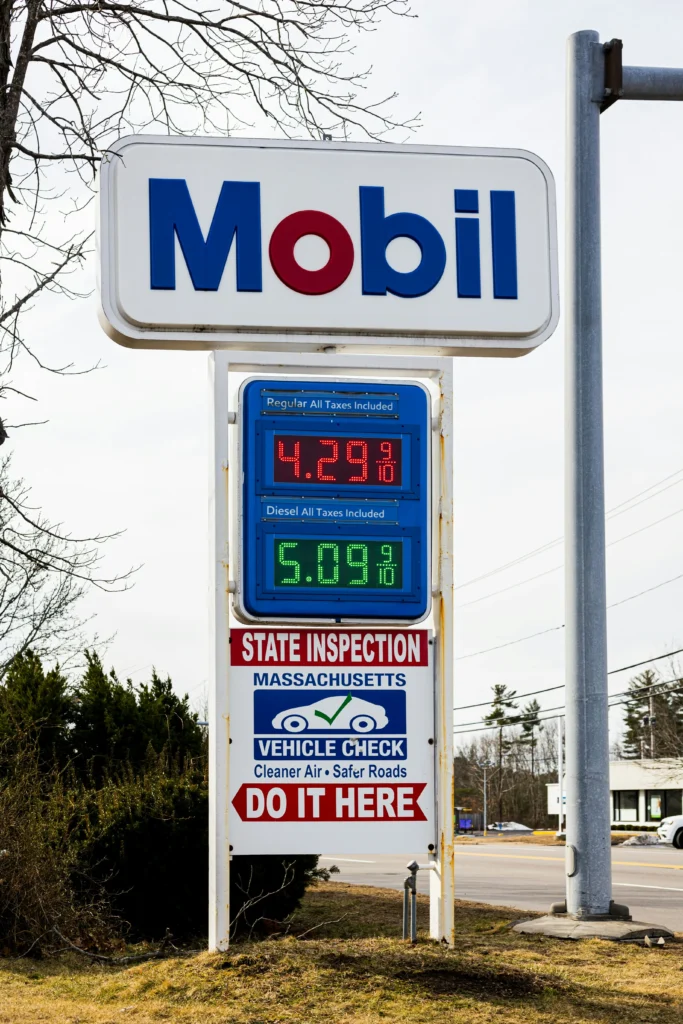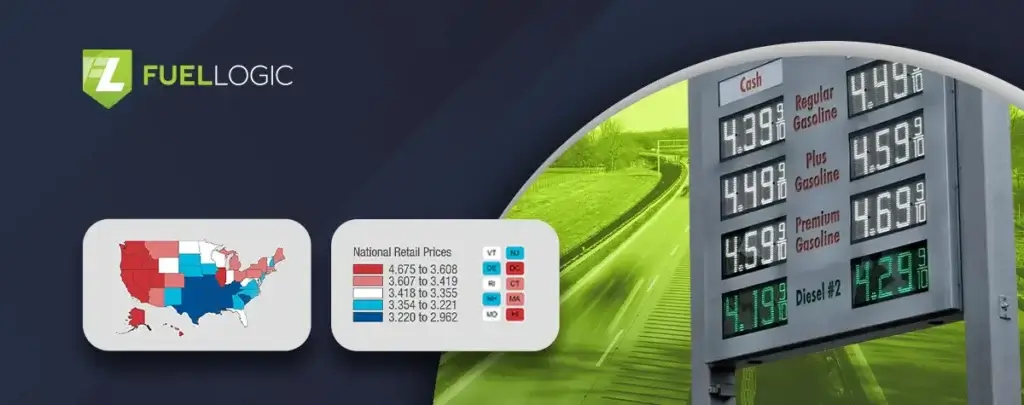Did you know that filling up your gas tank in Washington or California could cost nearly a dollar more per gallon than in Florida or Texas? Imagine driving from one state to another and noticing a sudden jump or drop in gas prices. This is not a coincidence. It’s the result of various state-specific factors that directly impact the cost of fuel.
According to AAA, the diesel price in California is $5.026 per gallon, while in Arizona, it is pretty low at $3.739 per gallon. The same goes for other states; fuel prices are skyrocketing in a few US states, while some states sell fuel at reasonable rates. So, why are gas prices going up? What factors cause such variations in fuel prices within the same country?
If these questions have been on your mind, you’ve come to the right place. This guide will explain the primary factors that influence the average gas prices by state. We’ll explain factors such as transportation costs, tax rates, market dynamics, and international influences. We’ll also guide you on how to manage gas prices to reduce your major business expenses.
TABLE OF CONTENTS

Read on to learn why California’s gas prices are higher than the other US states and what you can do about it.
Factors Influencing Gas Prices
Gas prices vary widely from state to state due to several reasons. Here are the key factors that impact these price differences:
State Taxes and Fees
State and local taxes on gasoline can greatly impact gas prices in the USA. States with higher fuel taxes will generally have higher prices at the pump. For example, according to data from the Tax Foundation for the fiscal year 2024, starting July 1, 2023, California has the highest gas taxes in the country at 77.9 cents per gallon. Similarly, Pennsylvania also has high taxes, at 62.2 cents per gallon. These are among the states with the highest fuel tax rates in the US.
In contrast, some states have much lower tax rates. For example, Alaska’s tax is just 9 cents per gallon, and Mississippi’s is 18.4 cents per gallon. However, standard federal taxes include 18.3 cents per gallon of gasoline and 24.3 cents per gallon of diesel fuel.
Environmental Regulations
Some states in the US require cleaner-burning fuels, which are more expensive to produce. Refineries use advanced technologies to meet these regulations, increasing gas prices. About one-third of the gasoline sold in the US is reformulated with additives to reduce pollution. Reformulated gasoline (RFG) is a type of gasoline that burns more cleanly than regular gasoline. It helps reduce smog and harmful pollutants in the air.
Environmental regulations may also require different fuel blends for summer and winter, causing temporary supply issues and price hikes. Apart from that, federal and state-specific regulations also cause these effects. Federal standards set a baseline, while state rules add further requirements.
Proximity to Refineries
States near refineries, like Louisiana and Texas, have cheaper gas prices. When fuel has to travel shorter distances from refineries to gas stations, the overall costs are lower. That’s why residents of Florida and other states with no refineries often voice their concerns as to why gas prices near me are higher. However, just having a refinery doesn’t guarantee low fuel costs; it also depends on the refinery’s capacity and proximity to crude oil sources. For example, Hawaii has one crude oil refinery, which processes about 94,000 barrels of crude oil daily. However, this refining capacity is relatively small compared to mainland refineries. Therefore, proximity to a refinery doesn’t necessarily mean a state will have low-cost fuel. It depends on whether the refinery processes enough fuel to meet local demand.
Distribution and Transportation Costs
Gasoline prices rise as the distance it travels increases. Retail gas prices increase when transportation costs hike due to longer distances from supply sources. Supply sources include large refineries, ports, and pipeline and blending terminals. States farther from these sources, like Alaska, California, Florida, and Hawaii, face higher gas prices due to the added cost of transporting fuel in bulk.
Infrastructure quality also plays a role; modern pipelines and roads reduce costs, while outdated infrastructure increases them. Geographical challenges, like Alaska’s remote location, Hawaii’s reliance on shipping, and California’s complex geography, increase transportation costs and raise gas prices.
Local Market Dynamics
Local supply and demand greatly affect gas prices. When demand is high and supply is limited, prices rise, especially during peak seasons or when refineries face outages. Competition among gas stations also influences prices. Gas prices drop in areas with many stations as they compete for customers. On the other hand, prices can be higher in states with fewer stations.
You might have seen offers like “buy a certain quantity of fuel for a lower rate.” This is all about supply. Bulk gas prices are usually lower per gallon compared to smaller purchases.
Seasonal Variations
Seasonal changes in demand can affect gas prices. For example, more people travel during summer, increasing demand for gasoline and elevating fuel prices. In winter, demand often drops, which can lower prices.
Gasoline blends also change with the seasons. In summer, refineries produce a unique blend for better engine performance. Summer blends cost more because the production process takes longer, and the gasoline yield per barrel is lower. These factors can add up to 15 cents per gallon to the cost of producing summer fuel. In winter, a different blend is used that’s cheaper to produce. The switch between these blends also causes price fluctuation.
Impact of Federal Policies
Federal fuel standards impact gas prices across states. Rules require blending ethanol with gasoline, which can raise production costs. The Energy Policy Act of 2005 encouraged biofuel research by offering grants, tax credits, and loans. It required 7.5 billion gallons of renewable fuels to be mixed with gasoline each year by 2012.
In 2007, the Energy Independence and Security Act (EISA) increased this goal, aiming for 36 billion gallons of biofuel production by 2022. Since 2022, the EPA has set annual targets for biofuel blending. As of 2024, these targets still guide how much biofuel is mixed with gasoline, affecting state-level prices.
The Role of International Factors
When global oil prices rise, gas prices nationwide usually increase. However, the effect can vary depending on local factors like transportation and taxes. States involved in significant oil import/export may experience unique price variations. For example, states with large refineries or ports may see different price impacts than those relying more on imported fuel. Gas prices can also be affected by international events. Issues like conflicts between countries, political instability, and disruptions in oil production can impact oil supply and, eventually, affect fuel prices.
Consumer Tips for Managing Gas Costs
Now that you understand why are gas prices going up, you must find strategies to manage these costs. Regularly maintain your vehicles and equipment with oil changes and tire checks to improve fuel efficiency. Here are the best consumer tips for managing gas costs:
- Train drivers to avoid rapid acceleration and braking to save fuel.
- Use navigation apps like Google Maps to find the shortest routes.
- Reduce idling by turning off the engine if parked for more than a minute.
- Use apps like GasBuddy and WEX Connect to find the best gas prices.
- Look for discounts through credit cards and loyalty programs for cost savings.
Key Takeaways
Gas prices vary from state to state due to several factors: local taxes, transportation costs, supply and demand, seasonal changes, and federal fuel rules. States with higher taxes or challenging locations often have higher on-road and off-road diesel prices due to higher tax rates and transportation charges. Global events and federal requirements also play a role. Understanding these factors is beneficial for consumers. It helps explain how prices can differ depending on where you live and how you can better manage your fuel expenses.

FAQs
Does the government control gas prices?
No, the government does not control gas prices. There is no single person or entity that sets gas prices; they are influenced by global market conditions and fluctuate based on supply and demand. The primary factor affecting the price we pay at the pump is the cost of crude oil.
What state has the cheapest gas?
Mississippi currently has the cheapest gas prices in the US. The average cost for regular gasoline is $2.974 per gallon, and diesel fuel is $3.476 per gallon.
Which state has the highest gas prices?
Hawaii has the highest gas prices in the US. The average price for regular gasoline is $4.659 per gallon, and diesel fuel costs $5.432 per gallon.
Who sets gas prices in each state?
Any central authority or group does not set gas prices. Instead, they are determined by market forces of supply and demand. The price of crude oil is the main factor, making up about 50% of the total cost. Other factors include refining costs (25%), distribution and marketing costs (11%), and federal and state taxes (14%).
Why is gas more expensive out west?
Gas is more expensive in western states due to higher state and local taxes, stricter environmental regulations that require more expensive fuel blends, and increased distribution costs. Moreover, there can be more demand and less competition, which also drives up prices.
How are gasoline prices set?
Gasoline prices are set based on supply and demand. If demand is high and supply is low, prices go up. The Organization of the Petroleum Exporting Countries (OPEC) influences prices by controlling a large portion of the world’s oil supply. In 2022, OPEC produced about 28.7 million barrels of oil per day, nearly 38% of the global fuel supply that year. Therefore, OPEC can impact crude oil prices by adjusting production levels. For example, when OPEC limits oil production, supply decreases and prices rise.
Optimize Your Fuel Costs with Fuel Logic
To better manage your fuel costs, check out the average gas prices by state to see how they compare in your area. If you have any fuel concerns or needs, don’t hesitate to contact Fuel Logic. With service locations across the lower 48 United States, we provide convenient access to all kinds of fuel, including gasoline, off-road diesel, and DEF Fuel at your business address.
We have an efficient delivery system that allows us to offer competitive fuel rates and reliable services. For the best rates and timely delivery, trust Fuel Logic to meet all your fuel delivery needs. Order fuel today and experience the difference.


